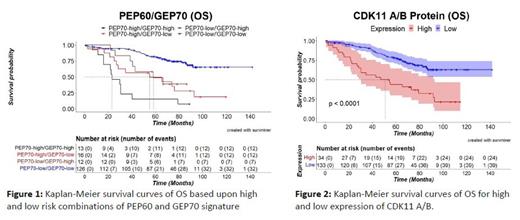Category
Multiple Myeloma and Plasma Cell Dyscrasias: Basic and Translational
Introduction
Although there have been many treatment advances for multiple myeloma (MM) that have led to increases in overall survival (OS) and progression free survival (PFS) for up to 20 years, the subset of patients with high-risk disease continue to have poor clinical outcomes, with median OS of less than 3 years. Our studies have focused on improving gene expression profiling (GEP) and IMWG risk classification of newly diagnosed MM (NDMM) by proteomics. We have developed a 60-protein risk score (PEP60) that captures a group of high-risk NDMM cases misclassified as low-risk by GEP70, a powerful 70-gene mRNA risk score. We discovered that protein and mRNA have low heterogeneity in MM (R=0.37). Strikingly, CDK11A/B was ranked top 14 th for inferior survival (OS) at the protein level but did not make it into the top 1000 most significant genes at the mRNA level, which was supported by low correlation (R=0.25). CDK11A/B has been previously identified as a druggable target in MM (Tiedemann et al. Cancer Res. 2012; 72(3): 757-768) and our study is the first to confirm its significance at the protein level in a large global proteomics study of patient samples (n = 167). Altogether, this study highlights the importance of discovering high-risk targets at the protein level and identifies CDK11A/B as a high-risk protein that would have been missed in transcript-only analysis.
Materials and Methods Total protein from primary bone marrow samples of CD138+ purified plasma cells was subjected to mass spectrometric analysis (n = 167 NDMM). A chromatogram library was assembled with Data Independent acquisition (DIA) spectra and precursor spectra were acquired after each DIA duty cycle, as previously described (Searle et al. Nat Commun 2018, 9:5128). Following data acquisition, data were searched using an empirically corrected library and a quantitative analysis was performed to obtain a comprehensive proteomic profile. Proteins were identified and quantified using EncyclopeDIA and visualized with Scaffold DIA using 1% false discovery thresholds at both the protein and peptide level. Expression was normalized by Variance Stabilizing Normalization (VSN). Heterogeneity between protein and mRNA (microarray) expression were compared across genes using Pearson correlation. Using the maxstat package in R, log-rank tests on 4,760 proteins were conducted and 60 high-risk proteins were selected (FDR<0.1%) to develop a prognostic protein risk score (PEP60). Kaplan-Meier curves revealing overall survival (OS) were constructed using the survival package in R.
Results: A geometric mean ratio of 34 upregulated proteins divided by 26 downregulated proteins (PEP60), sorted from low to high, show that patient deaths increase in Heatmap with increase in PEP60 score. Kaplan-Meier estimates of OS PEP60 and OS GEP70 in low-risk myeloma and high-risk myeloma showed increased inferior survival for PEP60 OS (P<0.001; HR = 4.49) compared to GEP70 OS (P<0.001; HR = 3.64). Kaplan-Meier estimates of OS for PEP60high/GEP70high (black), PEP60high/GEP70low (red), PEP60low/GEP70high (brown), and PEP60low/GEP70low (blue) showed significant inferior survival for the PEP60high/GEP70high group (P<0.001, HR = 9.07) compared to PEP60high/GEP70low (P<0.001, HR = 3.70) and PEP60low/GEP70high (P<0.001, HR = 3.03), demonstrating that PEP60 and GEP70 capture separate high-risk patients when only one is high ( Fig 1). Correlation of CDK11A/B mRNA (microarray) and protein show low correlation (R=0.25).Kaplan-Meier estimates of OS for CDK11A/B were highly significant for protein (P<0.001; HR = 3.00) ( Fig 2) but not as significant for mRNA (P=0.02; HR = 1.86).
Conclusion Protein and mRNA correlation of paired samples from 167 NDMM patients reveals a wide heterogeneity between expression at the mRNA and protein levels. Global proteomics Identified a subset of patients that have inferior survival that were previously missed in our high-risk model using mRNA expression (GEP70). CDK11A/B was identified as highly significant for inferior survival (OS) at the protein level but not at the mRNA level. This study shows the importance of proteomics for capturing high-risk proteins and identifies CDK11 A/B as a high-risk, druggable target in patients samples.
Disclosures
No relevant conflicts of interest to declare.


